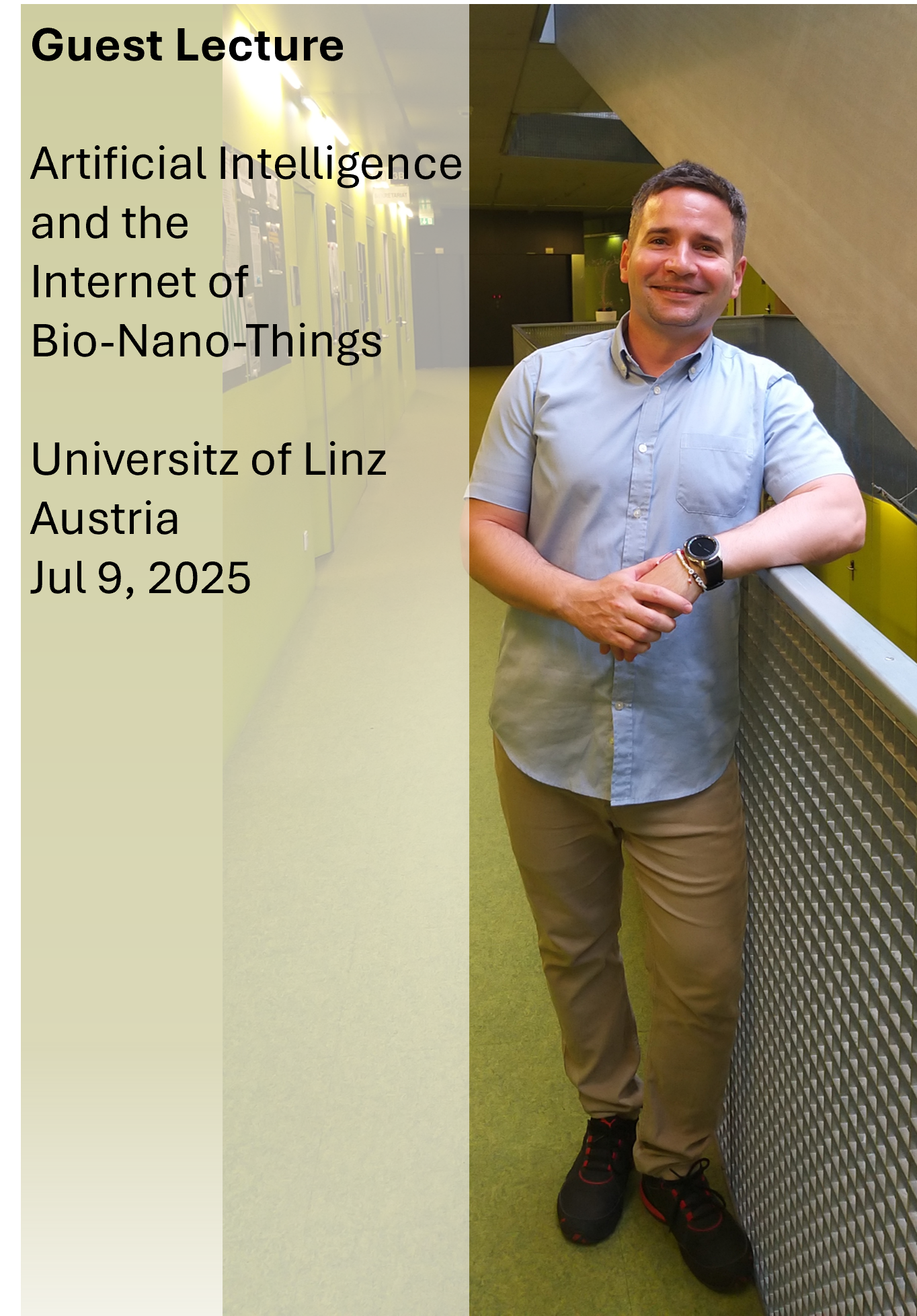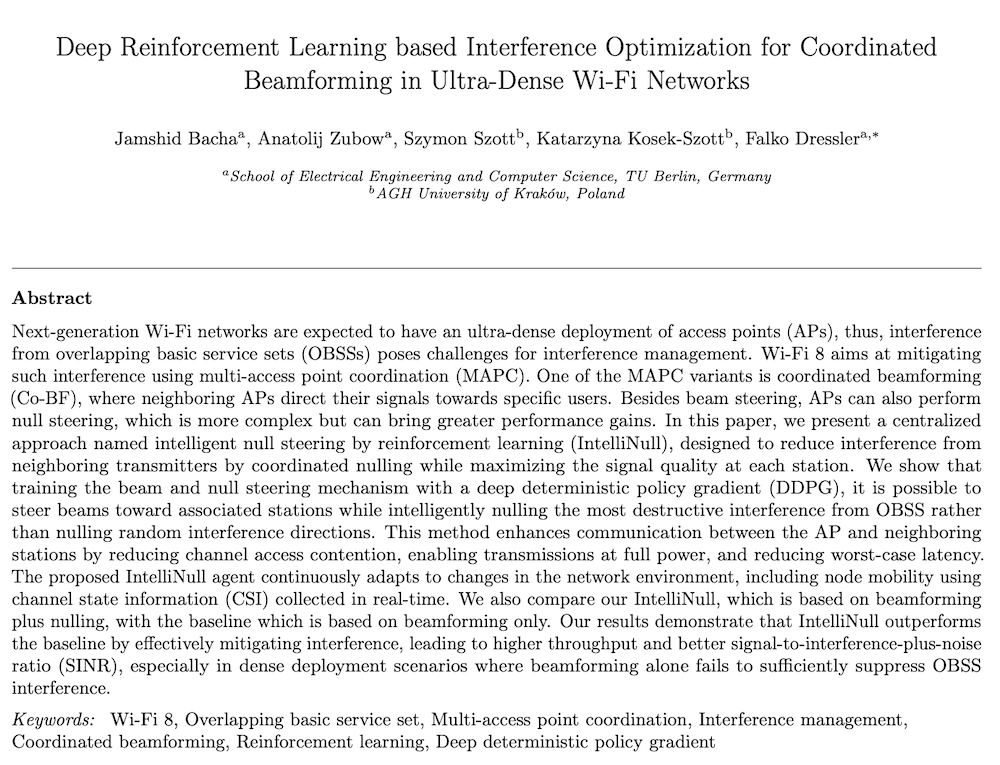Literature Database Entry
lopez2023toward
Arnau Brosa López, Filip Lemic, Jakob Struye, Jorge Torres Gómez, Esteban Municio, Carmen Delgado, Gerard Calvo Bartra, Falko Dressler, Eduard Alarcón, Jeroen Famaey, Sergi Abadal and Xavier Costa-Pérez, "Toward Standardized Performance Evaluation of Flow-guided Nanoscale Localization," arXiv, cs.NI, 2303.07804, March 2023.
Abstract
Nanoscale devices featuring Terahertz (THz)-based wireless communication capabilities are envisioned to be deployed within human bloodstreams. Such devices are envisaged to enable fine-grained sensing-based applications for detecting events for early indications of various health conditions, as well as actuation-based ones such as the targeted drug delivery. Intuitively, associating the locations of such events with the events themselves would provide an additional utility for precision diagnostics and treatment. This vision recently yielded a new class of in-body localization coined under the term "flow-guided nanoscale localization". Such localization can be piggybacked on THz-based communication for detecting body regions in which events were observed based on the duration of one circulation of a nanodevice in the bloodstream. From a decades-long research on objective benchmarking of "traditional" indoor localization, as well as its eventual standardization (e.g., ISO/IEC 18305:2016), we know that in early stages the reported performance results were often incomplete (e.g., targeting a subset of relevant metrics), carrying out benchmarking experiments in different evaluation environments and scenarios, and utilizing inconsistent performance indicators. To avoid such a "lock-in" in flow-guided localization, in this paper we discuss a workflow for standardized evaluation of such localization. The workflow is implemented in the form of an open-source framework that is able to jointly account for the mobility of the nanodevices in the bloodstream, in-body THz communication between the nanodevices and on-body anchors, and energy-related and other technological constraints at the nanodevice level. Accounting for these constraints, the framework is able to generate the raw data that can be streamlined into different flow-guided solutions for generating standardized performance benchmarks.
Quick access
Original Version ![]() (at publishers web site)
(at publishers web site)
Authors' Version ![]() (PDF on this web site)
(PDF on this web site)
BibTeX ![]()
Contact
Arnau Brosa López
Filip Lemic
Jakob Struye
Jorge Torres Gómez
Esteban Municio
Carmen Delgado
Gerard Calvo Bartra
Falko Dressler
Eduard Alarcón
Jeroen Famaey
Sergi Abadal
Xavier Costa-Pérez
BibTeX reference
@techreport{lopez2023toward,
author = {L{\'{o}}pez, Arnau Brosa and Lemic, Filip and Struye, Jakob and Torres G{\'{o}}mez, Jorge and Municio, Esteban and Delgado, Carmen and Bartra, Gerard Calvo and Dressler, Falko and Alarc{\'{o}}n, Eduard and Famaey, Jeroen and Abadal, Sergi and Costa-P{\'{e}}rez, Xavier},
doi = {10.48550/arXiv.2303.07804},
title = {{Toward Standardized Performance Evaluation of Flow-guided Nanoscale Localization}},
institution = {arXiv},
month = {3},
number = {2303.07804},
type = {cs.NI},
year = {2023},
}
Copyright notice
Links to final or draft versions of papers are presented here to ensure timely dissemination of scholarly and technical work. Copyright and all rights therein are retained by authors or by other copyright holders. All persons copying this information are expected to adhere to the terms and constraints invoked by each author's copyright. In most cases, these works may not be reposted or distributed for commercial purposes without the explicit permission of the copyright holder.
The following applies to all papers listed above that have IEEE copyrights: Personal use of this material is permitted. However, permission to reprint/republish this material for advertising or promotional purposes or for creating new collective works for resale or redistribution to servers or lists, or to reuse any copyrighted component of this work in other works must be obtained from the IEEE.
The following applies to all papers listed above that are in submission to IEEE conference/workshop proceedings or journals: This work has been submitted to the IEEE for possible publication. Copyright may be transferred without notice, after which this version may no longer be accessible.
The following applies to all papers listed above that have ACM copyrights: ACM COPYRIGHT NOTICE. Permission to make digital or hard copies of part or all of this work for personal or classroom use is granted without fee provided that copies are not made or distributed for profit or commercial advantage and that copies bear this notice and the full citation on the first page. Copyrights for components of this work owned by others than ACM must be honored. Abstracting with credit is permitted. To copy otherwise, to republish, to post on servers, or to redistribute to lists, requires prior specific permission and/or a fee. Request permissions from Publications Dept., ACM, Inc., fax +1 (212) 869-0481, or permissions@acm.org.
The following applies to all SpringerLink papers listed above that have Springer Science+Business Media copyrights: The original publication is available at www.springerlink.com.
This page was automatically generated using BibDB and bib2web.







